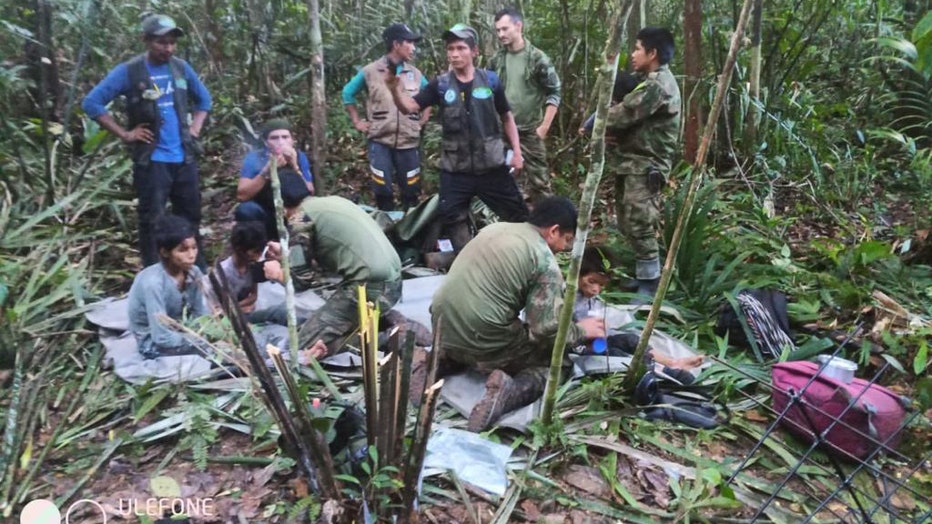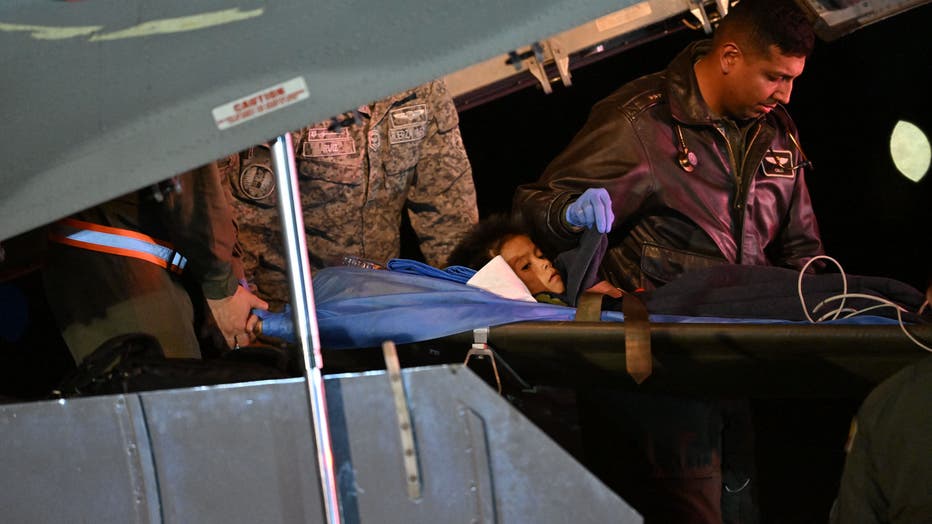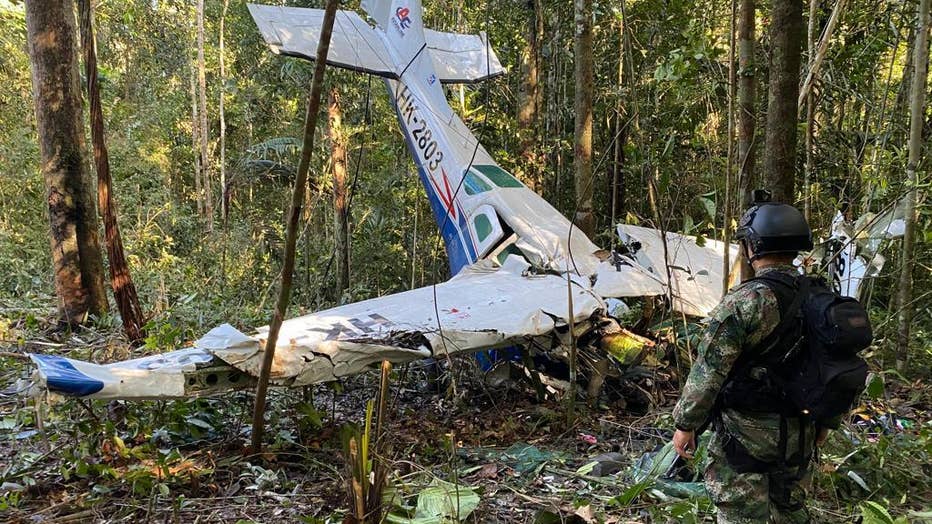Searchers who found children missing for 40 days turned to ayahuasca for help
BOGOTA, Colombia - The weary Indigenous men gathered at their base camp, nestled among towering trees and dense vegetation that form a disorienting sea of green. They sensed that their ancestral land — Selva Madre, or Mother Jungle — was unwilling to let them find the four children who'd been missing since their charter plane crashed weeks earlier in a remote area in southern Colombia.
Indigenous volunteers and military crews had found signs of hope: a baby bottle, half-eaten fruit, dirty diapers strewn across a wide swatch of rainforest. The men were convinced the children had survived. But punishing rains, harsh terrain and the passing of time had diminished their spirits and drained their stamina.
The weak of body, of mind, of faith do not make it out of this jungle. Day 39 was do or die — for the children and the search teams.

Colombian Military Forces help four children who survived 40 days in the Amazon jungle after their plane crashed in the department of Caqueta on June 9, 2023. (Photo by Colombian Military Forces / Handout/Anadolu Agency via Getty Images)
That night at camp, Manuel Ranoque, father of the two youngest children, reached for one of the most sacred rituals of Indigenous groups of the Amazon — yagé, a bitter tea made of plants native to the rainforest, more widely known as ayahuasca. For centuries, the hallucinogenic cocktail has been used as a cure for all ailments by people in Colombia, Peru, Ecuador and Brazil.
Henry Guerrero, a volunteer who joined the search from the children's home village near Araracuara, told The Associated Press his aunt prepared the yagé for the group. They believed it would induce visions that could lead them to the children.
"I told them, 'There’s nothing to do here. We will not find them with the naked eye. The last resource is to take yagé,'" Guerrero, 56, said. "The trip really takes place in very special moments. It is something very spiritual. For us, it is like the last resource."
Ranoque sipped, and the men kept watch for a few hours. When the psychotropic effects passed, he told them it hadn't worked.
Some searchers were ready to leave. But the next morning, 40 days after the crash, an elder reached for what little was left of the yagé and drank it. Some people take it to connect with themselves, cure illnesses or heal a broken heart. Elder José Rubio was convinced it would eventually help find the kids, Guerrero said.
Rubio dreamed for some time. He vomited, a common side effect.
This time, he said, it had worked. In his visions, he saw them. He told Guerrero: "’We’ll find the children today."
___
The four children — Lesly, Soleiny, Tien and Cristin — grew up around Araracuara, a small Amazon village in Caquetá Department that can be reached only by boat or small plane. Ranoque said the siblings had happy but independent lives because he and his wife, Magdalena Mucutuy, were often away from home.
Lesly, 13, was the mature, quiet one. Soleiny, 9, was playful, and Tien, nearly 5 before the crash, restless. Cristin, 11 months then, was just learning to walk.
At home, Mucutuy grew onions and cassava, and used the latter to produce fariña, a type of flour, for the family to eat and sell. Lesly learned to cook at age 8; in the adults' absence, she often cared for her siblings.
The morning of May 1, the children, their mother and an uncle boarded a light plane. They were headed to the town of San José del Guaviare. Weeks earlier, Ranoque had fled his home village, an area where illegal drug cultivation, mining and logging have thrived for decades. He told AP he feared pressure from people connected to his industry, though he refused to provide details about the nature of his job or business dealings.
"The work there is not safe," Ranoque said. "And it is illegal. It has to do with other people ... in a sector that I can’t mention because I put myself more at risk."
He said he left Mucutuy $9 million Colombian pesos, about $2,695 U.S. dollars, before leaving to pay for food, other necessities and the charter flight. He wanted the children out of the village because he feared they could be recruited by one of the rebel groups in the area.
They were on their way to meet Ranoque when the pilot of the Cessna single-engine propeller plane declared an emergency due to engine failure. The aircraft fell off the radar a short time later.
"Mayday, mayday, mayday ... The engine failed me again ... I’m going to look for a river ... I have here a river to my right," pilot Hernando Murcia reported to air traffic control at 7:43 a.m., according to a preliminary report released by aviation authorities.
"103 miles out of San José … I’m going to land."
___
The Colombian military launched a search for the plane when it failed to arrive at its destination. About 10 days later, with no plane and no signs of life found, the Indigenous volunteers joined the effort. They were much more familiar with the terrain and the families in the area. One man told them the plane was making an odd noise when it flew over his house. That helped them sketch out a search plan that followed the Apaporis River.
As they walked the unforgiving terrain and took breaks in groups, ants crawled on them and mosquitoes feasted on their blood. One searcher almost lost an eye to a tree branch, and others developed allergy- and flu-like symptoms.
They kept searching.
Historically, the military and indigenous groups have feuded, but deep in the jungle, after food supplies and optimism diminished, they shared water, meals, GPSs and satellite phones.
Sixteen days after the crash, with morale running low among all search parties, searchers found the wreckage. The plane appeared to have nosedived — it was was found in a vertical, nose-down position.
The group assumed the worst. The men had found the wreckage and seen human remains. Guerrero said he and others started packing up their camp.

One of the four Indigenous children who were found alive after being lost for 40 days in the Colombian Amazon forest following a plane crash, is stretchered out of a plane upon landing at the CATAM military base in Bogota on June 10, 2023. (Photo by
But one of the men who'd walked up to the plane spoke up.
"Hey," he said, according to Guerrero. "I didn't see the kids." The man slowly realized that when they found the wreckage, they hadn't seen any children's bodies. He'd approached the plane and seen the children's bags outside. He noticed that some stuff appeared as if someone had moved it after the crash.
He was right. The bodies of three adults were recovered from inside the aircraft. But there was no sign of the children, nor any indications they were seriously injured, according to the preliminary report.
The military's special operations forces changed its strategy, based on the evidence that the children might be alive. No longer were they quietly moving through the jungle.
"We moved on, to a second phase," 1st Vice Sgt. Juan Carlos Rojas Sisa said. "We went from the stealth part to the noise part so that they could hear us."
They yelled Lesly’s name and played a recorded message from the children’s maternal grandmother asking them in Spanish and the language of the Huitoto people to stay in place. Helicopters dropped boxes with food and leaflets with messages. The armed forces also brought its trained dogs, including a Belgian Shepherd named Wilson that did not return to its handler and is missing.
On the ground, nearly 120 members of the military and more than 70 Indigenous people were searching for the children, day and night. They left whistles for the children to use if they found them, and marked about 6.8 miles (11 kilometers) with crime scene-like tape, hoping the children would take the markings as a sign to stay put.
They began to find clues to the children's location, including a footprint they believed to be Lesly's. But no one could find the kids.
Some searchers had already walked more than 930 miles (1,500 kilometers) — the distance between Lisbon and Paris, or Dallas and Chicago. Exhaustion was setting in, and the military implemented a plan to rotate soldiers.
Guerrero made a call and asked for the yagé. It arrived two days later.
___
On day 40, after Elder Rubio took the yagé, the searchers combed the rainforest again, starting from the site where they found the diapers. His vision had reignited hopes but provided no specifics on where the children might be. Groups fanned out in different directions. But as the day went on, they returned to base camp with no news.
Sadness set in at camp. Guerrero told Ranoque as teams returned: "Nothing. We couldn't ... there is nothing."
Then came the news. A soldier heard via radio that the four children had been found — 5 kilometers (3 miles) from the crash site, in a small clearing. Rescue teams had passed within 20 to 50 meters (66 to 164 feet) on several occasions but missed them.
The solider told Guerrero, who ran to Ranoque. "They found the four," he said, through tears and hugs.
A helicopter lifted the kid out of the dense forest. They were first flown to San José del Guaviare and then to the capital, Bogota, each with a team of health care professionals. They were covered in foil blankets and hooked to IV lines due to dehydration. Their hands and feet showed scratches and insect bites.
Ranoque said Lesly reported that her mother died about four days after the crash. The children survived by collecting water in a soda bottle and eating cassava flour, fruit and seeds. They were found with two small bags holding clothes, a towel, a flashlight, two phones and a music box.
Tien and Cristin had birthdays while searchers looked for them.
All four remain in the hospital. A custody fight has broken out, with some relatives claiming Ranoque was violent against the children's mother. He has admitted to verbal and occasional physical fights, which he called "a private family matter." He's also said he's not been able to see the two oldest children.

Search and rescue teams of Colombian Army conduct operation at the scene after a plane crashed in the jungle more than two weeks ago in Colombia on May 19, 2023. (Photo by Colombian Army / Handout/Anadolu Agency via Getty Images)
Officials, medical professionals, special forces and others have praised Lesly's leadership. She and her siblings have become a symbol of resilience and survival across the globe. The Colombian government, meanwhile, has boasted of the cooperation among Indigenous communities and the military as it tries to end national conflicts.
"The jungle saved them," President Gustavo Petro said. "They are children of the jungle, and now they are also children of Colombia."
That's true, Ranoque told AP. But the Indigenous culture and rituals saved them, too; he credits the yagé and the vision of the elder among their group.
"This is a spiritual world," he said, and the yagé "is of the utmost respect. It is the maximum concentration that is made in our spiritual world as an indigenous people."
That's why they drank the tea in the jungle, he said: "That was so that the goblin, that cursed devil, would release my children."

